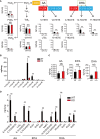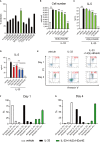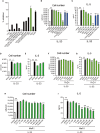12/15-Lipoxygenase Regulates IL-33-Induced Eosinophilic Airway Inflammation in Mice
- PMID: 34093589
- PMCID: PMC8170304
- DOI: 10.3389/fimmu.2021.687192
12/15-Lipoxygenase Regulates IL-33-Induced Eosinophilic Airway Inflammation in Mice
Abstract
Dysregulated fatty acid metabolism is clinically associated with eosinophilic allergic diseases, including severe asthma and chronic rhinosinusitis. This study aimed to demonstrate the role of 12/15-lipoxygenase (12/15-LOX) in interleukin (IL)-33-induced eosinophilic airway inflammation; to this end, we used 12/15-LOX-deficient mice, which displayed augmented IL-33-induced lung inflammation, characterized by an increased number of infiltrated eosinophils and group 2 innate lymphoid cells (ILC2s) in the airway. Liquid chromatography-tandem mass spectrometry (LC-MS/MS)-based lipidomics revealed that the levels of a series of 12/15-LOX-derived metabolites were significantly decreased, and application of 14(S)-hydroxy docosahexaenoic acid (HDoHE), a major 12/15-LOX-derived product, suppressed IL-33-mediated eosinophilic inflammation in 12/15-LOX-deficient mice. Using bioactive lipid screening, we found that 14(S)-HDoHE and 10(S),17(S)-diHDoHE markedly attenuated ILC2 proliferation and cytokine production at micromolar concentration in vitro. In addition, maresin 1 (MaR1) and resolvin D1 (RvD1), 12/15-LOX-derived specialized proresolving mediators (SPMs), inhibited cytokine production of ILC2s at nanomolar concentration. These findings demonstrate the protective role of endogenous 12/15-LOX-derived lipid mediators in controlling ILC2-mediated eosinophilic airway inflammation and related diseases. Thus, 12/15-LOX-derived lipid mediators may represent a potential therapeutic strategy for ameliorating airway inflammation-associated conditions.
Keywords: 12/15-lipoxygenase; 14(S)-HDoHE; IL-33; docosahexaenoic acid; group 2 innate lymphoid cell; lipidomics; maresin; specialized proresolving mediator.
Copyright © 2021 Miyata, Yokokura, Moro, Arai, Fukunaga and Arita.
Conflict of interest statement
The authors declare that the research was conducted in the absence of any commercial or financial relationships that could be construed as a potential conflict of interest.
Figures





Similar articles
-
Eosinophils and pleural macrophages counter regulate IL-33-elicited airway inflammation via the 12/15-lipoxygenase pathway.Front Immunol. 2025 Apr 17;16:1565670. doi: 10.3389/fimmu.2025.1565670. eCollection 2025. Front Immunol. 2025. PMID: 40313934 Free PMC article.
-
T-bet inhibits innate lymphoid cell-mediated eosinophilic airway inflammation by suppressing IL-9 production.J Allergy Clin Immunol. 2017 Apr;139(4):1355-1367.e6. doi: 10.1016/j.jaci.2016.08.022. Epub 2016 Sep 23. J Allergy Clin Immunol. 2017. PMID: 27670243
-
Immune responsive resolvin D1 programs peritoneal macrophages and cardiac fibroblast phenotypes in diversified metabolic microenvironment.J Cell Physiol. 2019 Apr;234(4):3910-3920. doi: 10.1002/jcp.27165. Epub 2018 Sep 7. J Cell Physiol. 2019. PMID: 30191990 Free PMC article.
-
The double-edged role of 12/15-lipoxygenase during inflammation and immunity.Biochim Biophys Acta Mol Cell Biol Lipids. 2017 Apr;1862(4):371-381. doi: 10.1016/j.bbalip.2016.07.014. Epub 2016 Jul 30. Biochim Biophys Acta Mol Cell Biol Lipids. 2017. PMID: 27480217 Review.
-
Inflammation and immune regulation by 12/15-lipoxygenases.Prog Lipid Res. 2006 Jul;45(4):334-56. doi: 10.1016/j.plipres.2006.02.003. Epub 2006 Mar 31. Prog Lipid Res. 2006. PMID: 16678271 Review.
Cited by
-
Gestational exposure to titanium dioxide, diesel exhaust, and concentrated urban air particles affects levels of specialized pro-resolving mediators in response to allergen in asthma-susceptible neonate lungs.J Toxicol Environ Health A. 2022 Mar 19;85(6):243-261. doi: 10.1080/15287394.2021.2000906. Epub 2021 Nov 21. J Toxicol Environ Health A. 2022. PMID: 34802391 Free PMC article.
-
Formation, Signaling and Occurrence of Specialized Pro-Resolving Lipid Mediators-What is the Evidence so far?Front Pharmacol. 2022 Mar 2;13:838782. doi: 10.3389/fphar.2022.838782. eCollection 2022. Front Pharmacol. 2022. PMID: 35308198 Free PMC article. Review.
-
Eosinophils and pleural macrophages counter regulate IL-33-elicited airway inflammation via the 12/15-lipoxygenase pathway.Front Immunol. 2025 Apr 17;16:1565670. doi: 10.3389/fimmu.2025.1565670. eCollection 2025. Front Immunol. 2025. PMID: 40313934 Free PMC article.
-
Helminth-induced prostaglandin signaling and dietary shifts in PUFA metabolism promote colitis-associated cancer.J Lipid Res. 2025 Jul;66(7):100837. doi: 10.1016/j.jlr.2025.100837. Epub 2025 Jun 7. J Lipid Res. 2025. PMID: 40490052 Free PMC article.
-
The Role of 12/15-Lipoxygenase and Its Various Metabolites Generated from Multiple Polyunsaturated Fatty Acids as Substrates in Inflammatory Responses.Biomed Res Int. 2022 Sep 25;2022:4589191. doi: 10.1155/2022/4589191. eCollection 2022. Biomed Res Int. 2022. Retraction in: Biomed Res Int. 2023 Jun 21;2023:9810176. doi: 10.1155/2023/9810176. PMID: 36199753 Free PMC article. Retracted. Review.
References
Publication types
MeSH terms
Substances
LinkOut - more resources
Full Text Sources
Medical

